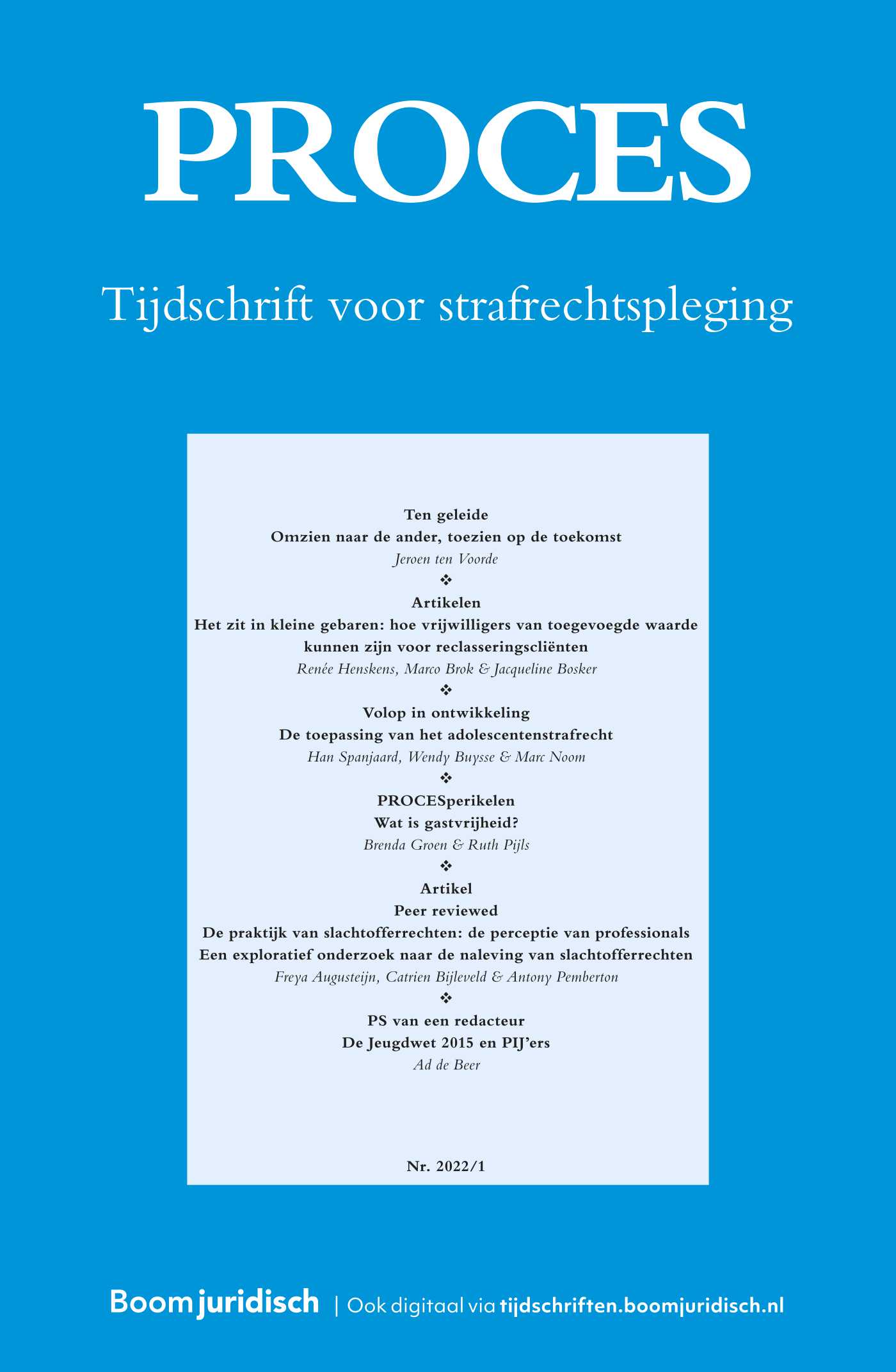|
In the near future, the legislator will decide on the criteria to be applied to make a choice between the administrative and the criminal justice system. It is a possibility that the legislator will depart from the so-called ‘open context’ and the ‘confined context’. In his Farewell Speech, Rogier pleaded that the severity of behavior should be the criterion to the applied. When behavior can be qualified as ‘serious’ a criminal procedure should take place and if the behavior is ‘less serious’ the administrative procedure has to be chosen. |


PROCES
Meer op het gebied van Criminologie en veiligheid
Over dit tijdschriftMeld u zich hier aan voor de attendering op dit tijdschrift zodat u direct een mail ontvangt als er een nieuw digitaal nummer is verschenen en u de artikelen online kunt lezen.
| Redactioneel |
Over de grens |
| Auteurs | Prof. dr. mr. Jeroen ten Voorde |
| Auteursinformatie |
| Artikel |
De keuze tussen strafrechtelijke en bestuursrechtelijke sanctionering en het criterium van de ernstige gedraging |
| Trefwoorden | Bestuursstrafrecht, Sanctiestelsel, Ernstige gedraging, Moraliteit, Strafrecht |
| Auteurs | Mr. dr. drs. Benny van der Vorm |
| SamenvattingAuteursinformatie |
| Artikel |
Dierenmishandelaars in beeld |
| Trefwoorden | Dierenmishandeling, Dierenmishandelaars, Dierenbeulen |
| Auteurs | Manon Hardeman en Anton van Wijk |
| SamenvattingAuteursinformatie |
|
In the media one notices items on mistreatment of animals on a regular basis. These can cause intense agitation in the society. Think of the many horses that have been abused throughout the country in 2012. This case remains unsolved to this day. The question is: who does this, who are the animal abusers, what are their characteristics and backgrounds? After a long search in several registration systems of many institutions the characteristics and backgrounds of 97 animal abusers have been found. The data of the institutions have also been used to create an image of the nature and extent of animal abuse. Subsequently there have been interviews with several experts from different organisations to record their knowledge and experience and to indicate the results. The characteristics and backgrounds of the animal abusers are diverse. Their ages range from 7 to 85 years. The offenders are an average of 34 years old at the time of committing the animal abuse. Animal abusers are not notorious criminals. Half is reported to be the first offender according to police data. The other half commits all forms of crime. This includes the share of capital offenses (34%) and violent crimes (23%). Dogs are most often abused. The motives are diverse. Disappearing anger and frustration seems to be an important reason to abuse animals. Only nine people found that there was domestic violence in addition to animal abuse. An initial classification of types of animal traffickers in, amongst others, group planners, loners and sadists, has to be empirically substantiated. |
| Artikel |
Hoe werkt vroegsignalering door lokale jongerenwerkers in de strijd tegen terrorisme? |
| Trefwoorden | Radicalisering, Gewelddadig extremisme, Jongerenwerker, Subjectieve oordeelsvorming |
| Auteurs | Annemarie van de Weert MSc en Mr. dr. Quirine Eijkman |
| SamenvattingAuteursinformatie |
|
This article analyses whether the local youth worker can operate on the intersection of social welfare and signalling of extremism. Although it is a rare phenomenon, there is a clear message from the government to watch out for the first signs of deviant behavior and unacceptable behavior. However, shouldn’t we ask ourselves whether youth workers are adequately equipped at local level to signal threat? The qualitative results show that in daily practice there is a lack of clear standards which make terminology for social professionals not easily distinguished. In addition their opinion depends largely on their own intuition regarding the issues. This can create side effects which form a risk that the local terrorism policy does not have the intended effect. |
| Praktijk |
Van onderzoek naar onderwijs: valorisatie in het hbo |
| Auteurs | Anne Boer MSc en Michelle Wismans MSc |
| Auteursinformatie |
| Artikel |
Nazorg voor ex-gedetineerden door Exodus: maakt het verschil?Recidiveonderzoek onder ex-gedetineerden die bij Exodus verbleven in de periode 1999-2012 |
| Trefwoorden | Recidive (Reoffending), Nazorg (Aftercare), Quasi-experimenteel onderzoek (Quasi-experimental research), Gevangenis (Prison), Exodus |
| Auteurs | Mr. dr. Sigrid van Wingerden, Suzan Verweij MSc, Dr. Bouke Wartna e.a. |
| SamenvattingAuteursinformatie |
|
Exodus is an organization aimed at assisting prisoners at their transition to society. In the Exodus halfway houses participants receive help in finding a house and a job, in improving relationships with family and friends and in giving meaning to life. This study uses a quasi-experimental design to investigate whether participating in the Exodus program reduces reoffending: the observed reoffending rate is compared to the reoffending rate that was predicted based on characteristics of the participants. The findings show that two years after leaving Exodus, 46.5% of the participants reoffended. This is 4.1 percent point less than the total population of former prisoners and 4.6 percent point less than the predicted reoffending rate. |
| Column |
Verbinden en loslaten |
| Auteurs | Janine Janssen |
| Auteursinformatie |
